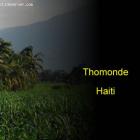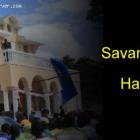ADVERTISEMENT
Tabaco - Haiti Observer Blog
Tabaco, Haiti Observer Blog. Read the following articles about Tabaco
Pignon In Haiti, Nord Department
This is a city you will find in the Nord region of Haiti, in the Saint-Raphael Arrondissement. Around 29,327 people inhabit it.
Pignon is naturally well protected town against possible tornadoes and tropical storms that are frequent in the area. It is situated in a valley that is safeguarded by gigantic mountains.
Jean Guillaume de Pignon, a French tradesmen and a plantation owner founded this beautiful town of Pignon in 1699. He settled his family in the village at the foot of the mountains, shortly after the Treaty of Ryswick was signed with Spain.
Ouanaminthe and Free Trade Zone
Ouanaminthe is one of the largest cityships situated within the Nord-Est Department. It has a population numbering 100,000, 10% of whom live in the metropolitan area. Located close to the Dominican Republic border, the Ouanaminthe people cross over via the Massacre River to peddle their wares twice weekly at the Dajabón market.
Ouanaminthe has a well-developed education system. It follows the Haitian model, beginning with Kindergarten, advancing to Primary, then Secondary, and finally University level. Private schools are numerous and church-sponsored. As part of the effort to make education accessible to all residents in Ouanaminthe, the Faith and Joy non-government organization, funded by the Jesuit Refugee Service, is building several new primary schools.
Mineral Wealth of Trou-du-Nord will not Benefit Haitians
Trou-du-Nord is a cityship, capital of the Trou-du-Nord Arrondissement, and part of Nord Est Department. It lies in the northeast region of Haiti, with a population of 37,405 residents living in three sub-divisions, Garcin, Roucou and Roche-Plate.
The education system has a smattering of primary and secondary schools, whose students need sponsorships to pay tuition and school supplies. The primary organization offering sponsorships is the L'eglise Baptiste Trou-du-Nord Church, funding the education of 300 schoolchildren at its eponymous school.
The most pressing health challenge in Trou-du-Nord is the presence of malaria that is everywhere. The American Red Cross has a distribution program, whereby it hands out bed-nets to child-bearing women and young children. The program has been an enormous success, lowering the cases of the lethal illness significantly.
Ferrier, originally named Maribeaux
Ferrier is a small cityship contained within the Fort Liberté Arrondissement, part of Nord Est Department. Located in north Haiti, it was established in 1932 and originally named Maribeaux. It was raised to the level of a cityship in 1946 and is comprised of a single commune, Maribaboux.
Farmers in Ferrier engage in sustainable farming. They produce oranges, tobacco, and limes, as well as livestock, to provide for themselves. The land in Ferrier is inadequately irrigated, but is a good place to grow rice, and has received funding from non-government organizations (NGO) to do so.
Infrastructure in Ferrier is underdeveloped. No road or electrical systems exist there, and the town is without an airport. If NGO workers want to travel out of the area, they must access airports miles away, the nearest being Les Cayes, and furthest, Port-au-Prince International Airport. The people in Ferrier also lack a hospital. To get medical attention, they must get to the nearest medical facility located 30 miles out of town in Milot.
Mombin-Crochu and Living condition
Many people in the town of Mombin-Crochu in the Vallieres Arrondissement live in poverty. Residents do not have the luxury of living a very comfortable life, as Mombin-Crochu is one of the poor towns in the country. In fact, children are forced to walk barefoot because they do not have money to buy slippers. They also walk just to go to school because only a few have access to donkeys, which are the main transportation in the town.
When it comes to utilities, residents in Mombin-Crochu have to go by without a regular supply of water and electricity because they could not afford it. In order to make fuel and cook, they use charcoal and wood fire.
Lascahobas Economy
Lascahobas sits amid the Central Plateau of the island of Haiti. It is a second-level administrative division and the capital of Lascahobas Arrondissement. With a population numbering 41,716 residents, it is a one-hour drive from the Haiti-Dominican republic border. Three sub-divisions comprise Lascahobas, Little Background, Hoye, and Juampus.
In Lascahobas, agriculture drives the economy. Local farmland produces coffee, sisal, tobacco, and sugar crops. Sold at the always-crowded town market, the sale of these products supports commerce as a vital component of the community. A principle reason agrarian activity flourishes in Lascahobas is the well-irrigated farmland that draws water from the Lascahobas River.
Our objective is to share with you news and information about Haiti and the people of Haiti. Traditions, habits and the way we were or grew are alive in this site. We highly recommend that you Subscribe to our Newsletter and also share with us some of the things that are memorable and made us unique people.

 Life After Death
Life After Death  Thomonde, Haiti
Thomonde, Haiti  Haitian Creole Translation
Haitian Creole Translation  Something to think about
Something to think about  The Town of Savanette, Haiti
The Town of Savanette, Haiti